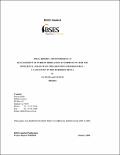| Abstract | The Burdekin Delta region depends on groundwater for irrigation and urban supply. Therefore, any adverse impacts on the groundwater resource are undesirable. Field studies were implemented to improve knowledge and understanding of impacts of current and modified irrigation management practices on crop water use, productivity and long-term sustainability of the Burdekin Delta groundwater system. Field trials were established on six sites representing different soil types of the Delta comparing conventional (CONV) and best management practice (BMP) irrigation systems. The BMP applied was site specific, and was determined by consultation with BSES extension officers and the individual grower. Sites were instrumented to measure irrigation application, crop water use and the quality of water draining beneath sugarcane crops.By using BMP irrigation, a reduction in water application of 15 and 14% was achieved during the 2001-2002 and 2002-2003 irrigation seasons, respectively. This equated to an average saving of 6.4 and 2.9 ML/ha, respectively. Crop production figures indicated an increase of 5% (7 t/ha) in 2001-2002 season and a decrease of 3% (4 t/ha) in 2002-2003. The combination of reduced water and increased yield in the 2001-2002 season resulted in a 24% overall increase in productivity across farms. The combination of reduced water and reduced yield in the 2002-2003 season resulted also in an increase in productivity of 11%. This was in line with the Cane Productivity Initiative (CPI) where an increase in productivity of 20% is expected across the Burdekin district.Deep drainage was calculated from each irrigation and summed for each season. By using BMP irrigation, deep drainage was reduced by 11 and 19% in the 2001-2002 and 2002-2003 irrigation seasons, equating to an average 1.8 and 1.9 ML/ha reduction in deep drainage respectively. Individual irrigation drainage water was analysed for nitrate-nitrogen, these figures were applied to drainage figures. Using BMP irrigation there was a reduction in nitrate-nitrogen loading across the Delta by 18% in 2001-2002 season (4.8 kg/ha) and by 39% (4.3 kg/ha) in the 2002-2003 season.Investigations into pesticide movement and acquisition by the groundwater resource were undertaken. There was no level of pesticides detected in groundwater samples. This was matched by soil water samples at 1.5 m and soil cores at 1.5 m. This is good news for the industry; there must now be a concerted effort to maintain this.From economic analysis of different irrigation system we can conclude that maintaining current furrow-irrigation practices is the most attractive option. Implementing centre-pivot irrigation systems is the second most attractive option, as it has higher net present value than furrow. Implementation of trickle irrigation is the least attractive to growers due to high initial capital outlay. Furrow irrigation remains most attractive under current water pricing schedules when key parameter values are varied.This project could not have been undertaken without the support from RWUEI, BSES Limited, NPIRD, CSIRO, the North and South Burdekin Water Boards and the valuable cooperation of the participating cane growers. |

